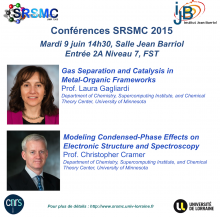Gas Separation and Catalysis in Metal-Organic Frameworks
Laura Gagliardi
Department of Chemistry, Supercomputing Institute, and Chemical Theory Center, University of Minnesota, Minneapolis, Minnesota, 55455, USA
Metal-organic frameworks (MOFs) are attracting the attention of many scientists because of their high selectivity in gas separations, catalytic activity, and magnetic properties. Many of these properties are linked to the presence of open-site transition metal ions, which may have open shells depending on their dn configuration and their coordination environments inside the framework. Among this newly popular class of materials, the M2(dobdc) (M = transition metal, dobdc4- = 2,5-dioxido-1,4-benzenedicarboxylate) systems are particularly noteworthy. They exhibit very high performance for various gas separations and promising catalytic properties.I will present several examples of the interplay between experiment and theory in order to address some of the challenging chemistry that occurs in these materials, including our latest results on the M2(dobdc) (M= Mg, Fe, Ni, Co) class of materials, obtained using quantum chemical calculations in combination with classical simulations. Our studies are aimed at understanding the interaction of various guests, including CO2, with M2(dobdc)1,2 and CH bond activation by N2O in the M2(dobdc) materials.3,4 I will also discuss our recent computational studies of the post-synthetic functionalization of the Zr6-based NU1000 metal- organic frameworks to imbue it with catalytic properties.5
- K. Lee, W. Isley III, A. Dzubak, P. Verma, S. Stoneburner, L.-C. Lin, J. Howe, E. Bloch, D. Reed, M. Hudson, C. Brown, J. Long, J. Neaton, B. Smit, C. Cramer, D. Truhlar, and L. Gagliardi, “Design of a metal-organic framework with enhanced back bonding for the separation of N2 and CH4”, J. Am. Chem. Soc. 136, 698–704 (2014)
- N. Planas, A. Dzubak, R. Poloni, L. Lin, A. McManus, T. McDonald, J. Neaton, J. Long, B. Smit, L. Gagliardi, “The Mechanism of Carbon Dioxide Adsorption in an Alkylamine-Functionalized Metal - Organic Framework”, J. Am. Chem. Soc. 135, 7402-7405 (2013)
- D.J.Xiao,E.D.Bloch,J.A.Mason,W.L.Queen,M.R.Hudson,N.Planas,J.Borycz,A.L.Dzubak,P. Verma, K. Lee, F. Bonino, V. Crocellà, J. Yano, S. Bordiga, D. G. Truhlar, L. Gagliardi, C. M. Brown, and J. R. Long, Oxidation of ethane to ethanol by N2O in a metal–organic framework with coordinatively unsaturated iron(II) sites, Nature Chemistry, 6, 590-595 (2014)
- Pragya Verma, Konstantinos Vogiatzis, Nora Planas, Joshua Borycz, Dianne J. Xiao, Jeffrey R. Long, Laura Gagliardi, and Donald G. Truhlar, "Mechanism of Oxidation of Ethane to Ethanol at Iron(IV)–Oxo Sites in Magnesium-Diluted Fe2(dobdc)," J. Am. Chem. Soc., DOI: 10.1021/jacs.5b00382 (2015)
- N. Planas, J. E. Mondloch, S. Tussupbayev, J. Borycz, L. Gagliardi, J. T. Hupp, O. K. Farha, C. J. Cramer, Defining the Proton Topology of the Zr6-Based Metal-Organic Framework NU-1000, J. Phys. Chem. Lett., 5, 3716–3723 (2014)
Modeling Condensed-Phase Effects on Electronic Structure and Spectroscopy
Christopher Cramer
Department of Chemistry, Supercomputing Institute, and Chemical Theory Center, University of Minnesota, Minneapolis, Minnesota, 55455, USA
Continuum models continue to offer an especially efficient means to introduce into an electronic structure calculation the effects of a surrounding medium on molecular properties and energetics. Recent developments in Minnesota solvation models include the optimization of a generalized Born formalism based on mapped Hirshfeld charges that essentially eliminates prior instabilities associated with atomic partial charges computed with extended basis sets. In addition, the modified Hirshfeld approach permits a natural computation of atomic polarizabilities that leads to insight and a more physical estimate of dispersion contributions to solvation free energies. This increased physicality in the solvation model allows for the analysis of solvatochromic effects in UV/Vis electronic spectra with a greater level of detail than has previously been possible. In addition to covering these latest developments, a short overview of continuum models with one or two applications to topics of present interest will be provided.

